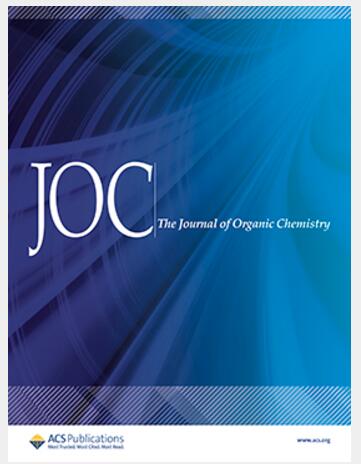作为反应中间体的重氮环丁烯:硫代炔和偶氮二羧酸的级联环化生成四氢吲哚。
IF 3.6
2区 化学
Q1 CHEMISTRY, ORGANIC
引用次数: 0
摘要
我们描述了一种新的一锅合成方法来获得高功能化的四氢吲哚和相关的熔融吡咯。这一转变的关键是在烯炔硫化物和偶氮二羧酸之间发生了强大的级联环化反应,包括重氮环丁烯的形成,引发了快速的电环开环,形成α-亚氨基硫咪酯中间体,然后是环化和芳构化,以获得高产率的n -杂环。这种策略代表了对四氢吲哚基序的传统方法的重大背离,传统方法通常涉及进行140年历史的Paal-Knorr环化或利用过渡金属催化。进一步的合成应用表明,该方法可以有效地用于复杂生物活性分子或天然产物样结构的后期功能化。对杂环产物的环合反应机理进行了计算探讨,发现其更符合极性过程,而非一致的aza-Nazarov环合反应。产物可以在机械上有趣的脱硫反应中利用,或在温和条件下转化为高取代的吲哚。本文章由计算机程序翻译,如有差异,请以英文原文为准。
Diazacyclobutenes as Reactive Intermediates: The Cascade Cyclization of Thiolated Ene-ynes and Azodicarboxylates to Provide Tetrahydroindoles.
We describe a new one-pot synthesis to access richly functionalized tetrahydroindoles and related fused pyrroles. The key to this transformation is a robust cascade cyclization between ene-yne sulfides and azodicarboxylates involving diazacyclobutene formation primed for rapid electrocyclic ring opening to an α-iminothioimidate intermediate, followed by cyclization and aromatization to yield the N-heterocycles in good yields. This tactic represents a significant departure from conventional approaches to the tetrahydroindole motif, which typically involve either staging the 140-year-old Paal-Knorr cyclization or leveraging transition metal catalysis. Further synthetic applications demonstrated that this method can be used for the late-stage functionalization of complex bioactive molecules or natural product-like structures in an efficient manner. The mechanism of the cyclization event leading to the heterocyclic products was probed computationally and is more consistent with a polar process instead of a concerted aza-Nazarov cyclization. The products can be leveraged in a mechanistically interesting desulfination reaction or converted to highly substituted indoles under mild conditions.
求助全文
通过发布文献求助,成功后即可免费获取论文全文。
去求助
来源期刊

Journal of Organic Chemistry
化学-有机化学
CiteScore
6.20
自引率
11.10%
发文量
1467
审稿时长
2 months
期刊介绍:
Journal of Organic Chemistry welcomes original contributions of fundamental research in all branches of the theory and practice of organic chemistry. In selecting manuscripts for publication, the editors place emphasis on the quality and novelty of the work, as well as the breadth of interest to the organic chemistry community.
 求助内容:
求助内容: 应助结果提醒方式:
应助结果提醒方式:


